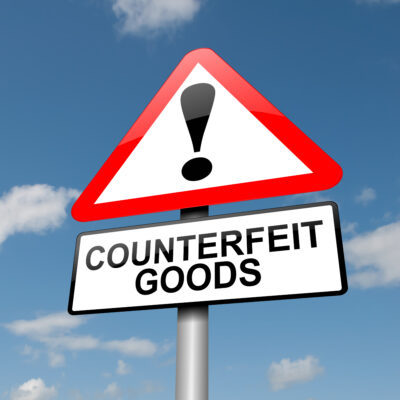“23% of respondents to MarqVision’s survey said they do not have the proper resources to prevent counterfeits. Also, 29% of brands surveyed did not have a documented strategy to combat IP infringement.”
 A report released Wednesday by MarqVision found that 68% of direct-to-customer (DTC) brands have had their products counterfeited. The report surveyed 295 representatives from DTC brands across the world.
A report released Wednesday by MarqVision found that 68% of direct-to-customer (DTC) brands have had their products counterfeited. The report surveyed 295 representatives from DTC brands across the world.
The report also provides information about how worried DTC brands are about IP infringement and counterfeiting. The DTC market has tripled over the last five years, accounting now for $1 of every $7 spent, according to the report.
Additionally, MarqVision asked survey respondents where they found the counterfeit products being sold. The most frequent culprits were fake websites made to look like the real brand and major U.S. marketplaces like Amazon and eBay.
Fortunately for the brands surveyed, 88% of them were able to have the counterfeits removed once they were identified.
“Counterfeiting is one of the biggest threats brands will face in 2023, but once brands discover where their products are being counterfeited — typically fake websites or major online marketplaces — the issue can be resolved,” said Mark Lee, co-founder and CEO of MarqVision.
Methodology
The company surveyed 295 individuals from companies across the world using Pollfish. The survey respondents included directors, executives, owners, and senior management. Approximately 70% of those surveyed represented firms in the United States.
Of the brands surveyed, about half sell apparel and accessories, with home goods and health products as the second and third most common products sold among the 295 respondents.
The majority of respondents were relatively new brands, with 82% of the respondents having begun selling products after the beginning of the COVID-19 pandemic.
The bulk of the sales from survey respondents was made through large marketplace websites, such as Amazon or Alibaba. 28% of sales came from companies’ own websites.
Most Counterfeiting Culprits Found on Fake Websites or Large Marketplaces
The report found that the counterfeited products were identified across a wide range of online sources, with many respondents saying they found counterfeit products on multiple websites.
Of the respondents that reported seeing their products counterfeited, 59% found fake websites built to look like their own that were selling counterfeit products. Coming in at a close second, 56% of respondents reported finding counterfeits on major U.S. e-commerce platforms, including Amazon and eBay.
Many brands surveyed were also affected by counterfeiting on non-U.S. marketplaces, with 41% of respondents reporting that they found counterfeit products on sites like Alibaba. Respondents to the survey reported foreign marketplaces to be the most difficult to remove counterfeits from.
Social media also plays an important role in sales and e-commerce, and a quarter of survey respondents found counterfeits of their brand’s products being sold on social media websites.
Removing Counterfeit Products
The greatest damage to most companies was not lost revenue; 72% of those counterfeited said that the biggest impact was the company’s reputation being damaged.
The majority of companies were able to remove the counterfeit products. However, this process was not always easy.
About half of the respondents reported that marketplaces based in Asia, such as Alibaba and Taobao, were the most difficult websites to remove counterfeit products. And of the 12% of brands that did not pursue legal recourse to remove counterfeits, the majority said they did not because the counterfeiters were outside of their jurisdiction.
Additionally, the number one answer that brands gave when asked what the most difficult challenge is when protecting their IP was detecting counterfeit products on foreign websites.
Did Counterfeiting Increase During the Pandemic?
One factor that may have increased counterfeiting was the explosion of e-commerce during the COVID-19 pandemic.
74% of survey respondents reported seeing an increase in counterfeit goods since the outbreak of the pandemic.
A 2022 report from the European Union Intellectual Property Office (EUIPO) similarly found that counterfeit goods had increased “sharply” during the COVID-19 pandemic.
“The COVID-19 pandemic has presented new business opportunities for criminals to distribute counterfeit and substandard goods,” said Europol’s Executive Director, Catherine De Bolle.
How Brands Can Protect IP
According to a 2020 report from the United States Patent and Trademark Office (USPTO), “counterfeiting is the largest criminal enterprise in the world.”
But 23% of respondents to MarqVision’s survey said they do not have the proper resources to prevent counterfeits. Also, 29% of brands surveyed did not have a documented strategy to combat IP infringement.
“To be successful in the fight against counterfeiters and minimize damages, it is imperative to prioritize the creation of a brand protection strategy,” said Lee.
In addition to publicizing data from its survey, MarqVision also provided tips for how brands can protect their IP and prevent counterfeits.
The first and most important point that MarqVision found from its research was to have a registered trademark in all countries a company expects to do business. From the survey data results, 92% of the companies that filed IP infringement cases won and this was “likely because of trademarks in place.”
Additional tips include adopting a global monitoring strategy, either manual or automated, and staying abreast of the latest trends and news in the IP space.
Image Source: Deposit Photos
Image ID: 11106692
Author: 72soul

![[IPWatchdog Logo]](https://ipwatchdog.com/wp-content/themes/IPWatchdog%20-%202023/assets/images/temp/logo-small@2x.png)

![[Advertisement]](https://ipwatchdog.com/wp-content/uploads/2024/04/Patent-Litigation-Masters-2024-sidebar-early-bird-ends-Apr-21-last-chance-700x500-1.jpg)

![[Advertisement]](https://ipwatchdog.com/wp-content/uploads/2021/12/WEBINAR-336-x-280-px.png)
![[Advertisement]](https://ipwatchdog.com/wp-content/uploads/2021/12/2021-Patent-Practice-on-Demand-recorded-Feb-2021-336-x-280.jpg)
![[Advertisement]](https://ipwatchdog.com/wp-content/uploads/2021/12/Ad-4-The-Invent-Patent-System™.png)







Join the Discussion
No comments yet.